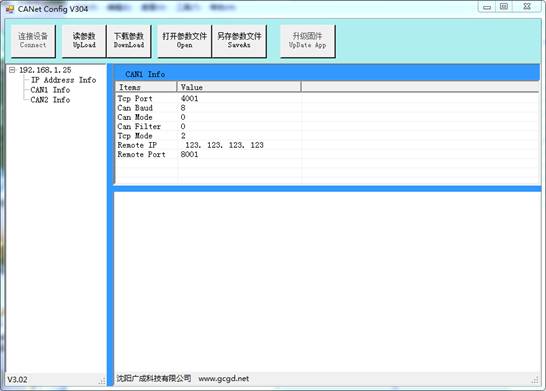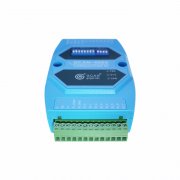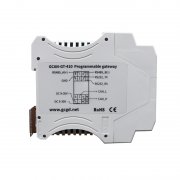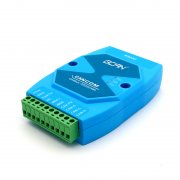Read CAN bus device status remotely by Ethernet to CAN
Today we are going to show you the GCAN-202 Ethernet to CAN converter which can make you read CAN bus device status remotely. It is so convenient for engineer to check the devices in a long distance even in other cities.
How can GCAN make this happen? GCAN-202 is a high-performance Ethernet to CAN bus communication conversion module that integrates two CAN interfaces and one Ethernet interface. The GCAN-202 Ethernet to CAN module can convert the CAN signal sent by the CAN device to the Ethernet data and transfer to the server. Then the terminal device can read, receive and use the CAN data to further expand the range of the CAN-bus network.
Before using, we should configure the GCAN-202 first. Note that the IP address of the GCAN-202 itself must be in the same network segment as the router and the IP address does not conflict with other devices.
The configuration process is very simple. Set the GCAN-202 Ethernet to CAN gateway to TCP Client mode to connect to the LAN server, then set the CAN baud rate to be the same as the CAN bus network or CAN bus device.
The configuration in this example is as shown in Figure 1 and Figure 2, the IP of the GCAN-202 Ethernet to CAN converter is configured to 192.168.1.25, the baud rate of the CAN terminal is configured to 100k, and the IP and port number of the server to be connected are set, for example, the IP is 123.123. 123.123, the port number is 8001. (Note: The above values should be set according to the actual situation)
After configuring the parameters, the GCAN-202 Ethernet to CAN gateway module should be powered on again. At this time, it will automatically connect to the pre-set server. After the connection, if there is data on the CAN bus, GCAN-202 Ethernet to CAN converter will automatically send data to the server.
The schematic is shown in Figure 3.
(1) Each server has a fixed IP address, such as 123.123.123.123. This IP is fixed, so you must set the IP and port number of the server accurately when setting up GCAN-202 Ethernet to CAN converter.
(2) GCAN-202 itself also belongs to a terminal of the connected network, so its IP address cannot be duplicated with other terminal addresses on the network, otherwise it will not connect to the server.
There are two ways to get data:
(1) The server can be accessed remotely, the specific software on the server opens the device, and then the data of the CAN bus is read.
(2) A software can be developed twice on the server, and automatically forwarded to other terminals, such as a PC, after receiving the data.
With GCAN-202 Ethernet to CAN converter, the CAN bus can be connected to the LAN server by simple configuration, and the communication status of remote CAN bus devices can be read remotely by using a computer, saving engineers a lot of time, effort and cost.
How can GCAN make this happen? GCAN-202 is a high-performance Ethernet to CAN bus communication conversion module that integrates two CAN interfaces and one Ethernet interface. The GCAN-202 Ethernet to CAN module can convert the CAN signal sent by the CAN device to the Ethernet data and transfer to the server. Then the terminal device can read, receive and use the CAN data to further expand the range of the CAN-bus network.
Before using, we should configure the GCAN-202 first. Note that the IP address of the GCAN-202 itself must be in the same network segment as the router and the IP address does not conflict with other devices.
The configuration process is very simple. Set the GCAN-202 Ethernet to CAN gateway to TCP Client mode to connect to the LAN server, then set the CAN baud rate to be the same as the CAN bus network or CAN bus device.
The configuration in this example is as shown in Figure 1 and Figure 2, the IP of the GCAN-202 Ethernet to CAN converter is configured to 192.168.1.25, the baud rate of the CAN terminal is configured to 100k, and the IP and port number of the server to be connected are set, for example, the IP is 123.123. 123.123, the port number is 8001. (Note: The above values should be set according to the actual situation)
After configuring the parameters, the GCAN-202 Ethernet to CAN gateway module should be powered on again. At this time, it will automatically connect to the pre-set server. After the connection, if there is data on the CAN bus, GCAN-202 Ethernet to CAN converter will automatically send data to the server.
The schematic is shown in Figure 3.
(1) Each server has a fixed IP address, such as 123.123.123.123. This IP is fixed, so you must set the IP and port number of the server accurately when setting up GCAN-202 Ethernet to CAN converter.
(2) GCAN-202 itself also belongs to a terminal of the connected network, so its IP address cannot be duplicated with other terminal addresses on the network, otherwise it will not connect to the server.
There are two ways to get data:
(1) The server can be accessed remotely, the specific software on the server opens the device, and then the data of the CAN bus is read.
(2) A software can be developed twice on the server, and automatically forwarded to other terminals, such as a PC, after receiving the data.
With GCAN-202 Ethernet to CAN converter, the CAN bus can be connected to the LAN server by simple configuration, and the communication status of remote CAN bus devices can be read remotely by using a computer, saving engineers a lot of time, effort and cost.
Welcome to contact us, if you want to know more about GCAN and GCAN products.
Tel: +86 13609896275.
Email: sygckj@gmail.com









